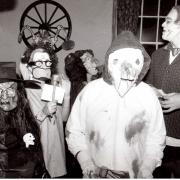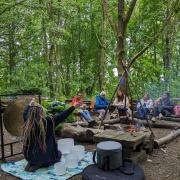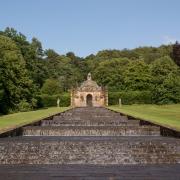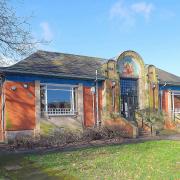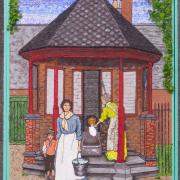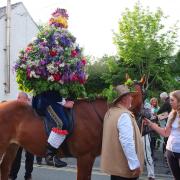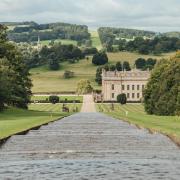The Derbyshire Record Office is a treasure trove of archives which offers a fascinating insight into the lives of those who came before us. In the first instalment of a new series, Nathan Fearn seeks out absorbing first-hand accounts of the past. Few places crystallise our local past quite like a visit to Derbyshire Record Office.
For those partial to a bit of Dr Who, it has the feeling of walking into the Tardis – seemingly small and confined from the outside but, look within, and it is astonished to see what is contained.
Browsing for hours through the social history of a town brings about quite visceral feelings of nostalgia for a time we did not know, which is rather strange if you think about it.
There’s one thing that stands out above any other though – how much has changed yet, paradoxically, how much has stayed the same.

This is a different world to that of the 1920s, the decade I paid particular attention to on my visit.
While locals of a century ago would struggle to identify with the world of the 21st century in many regards, it’s fascinating to see just how many societal values and discussion points remain just as valid and relevant today.
Recent years, for example, have seen Matlock battered by numerous weather events, resulting in a large-scale flood defence project in the town.
This is nothing new, though. And this newspaper cutting from 1928 will paint a familiar picture to many locals – perhaps minus the horse and cart!
‘In a country where the climate is one of the most variable – and often most unreasonable – known in the world, Matlock perhaps, lives up to the national reputation as much as any part of the British Isles,’ it reads.
‘But even the people of Matlock, used as they are to rapid and unexpected weather changes, have experienced weather conditions during the past couple of months which, for variety, are probably unsurpassed within living memory.
‘The road was completely free of water at 2.30, but little more than an hour later the road resembled a river, and already several motors were unable to move.
‘The water continued to rise with amazing rapidity, and by four o’clock, Bakewell Road, Crown Square, Causeway Lane, and the Hall Leys were submerged, the depth being several feet in places.
‘The Council provided horses and carts to “ferry” people from Crown Square to Bakewell Road, the Darley Dale buses kept the service going by way of Imperial Road and The Dimple, and a connection was maintained with Matlock Green by all buses altering their original route.
‘Shopkeepers in Crown Square and Bakewell Road had a busy, but futile time, endeavouring to keep the water from their premises, but the flood rapidly filled the cellars and trickled into shops and rooms on the ground floor, so that the only thing the occupants could do was sit still and wait for it to subside.
‘The caravan dwellers on the Bakewell Road were amongst the unluckiest people in the neighbourhood. Those in the lower fields on the river side were dragged on to the road, but one habitation, constructed from an old bus, could not be moved and had to take its chance.’

In 2024, local plans, decisions and developments can result in feelings run high. Twas ever thus.
Ever played miniature golf at Hall Leys Park? If some had had their way 100 years ago, you wouldn’t have done.
‘A protest from croquet players who frequent the Hall Leys Park, Matlock, because one of their lawns has been confiscated for miniature golf purposes was discussed at Monday’s meeting of the Matlock Urban District Council,’ reads the article.
‘The chairman pointed out that that croquet players had had the privilege of using two lawns for 15 years, and as several had purchased their season tickets when there were two court available, they had no right to take one away now. They provided ample facilities for other games on the Hall Leys, and it was only fair to do the same for the croquet players.
‘Mr Sadler said he had never seen anyone waiting to play croquet, but there were often people waiting to play golf.
‘A petition was read from nine croquet players asking for the restoration of the second lawn, and pointing out that they had two lawns at their disposal for the past 17 years.
‘The Chairman moved that the other lawn should be reinstated, but only three voted for the proposition.’
Marriages have, of course, taken place in Matlock for centuries and some have created quite the local stir.
Here, two recorded marriages catch the eye for very different reasons.

‘“The third time pays for all,” was all Edwin Alsop, an 80-years-old gardener, would say to me today, quoting the old proverb, when I asked him to talk about his experiences of married life,’ reports a local correspondent.
‘He is to be wedded for the third time on Monday, and his bride is a woman of thirty.
‘“I think it’s time I married again,” he added with a merry smile. “We don’t intend to go away for a honeymoon as I have a nice home to take my young lady to.”’
‘An unfortunate wedding hitch occurred at St. Giles’ Parish Church, Matlock, yesterday morning. A wedding party and large congregation assembled to witness the marriage of Mr. Percy Bridge, of Lime Grove Avenue, Matlock, captain of the Dean Hills Tennis Club, to Miss Evelyn Poulson, of New Street, Matlock, a member of the same club,’ reads a report from the same year.
‘On the arrival the Rector (the Rev. A. Urling Smith) refused to perform the ceremony. The difficulty seems to have been that the parties reside in All Saints’ Parish, and that the banns should have been called in the church as well as in the one in which the ceremony was arranged to take place, a formality which was omitted.
‘Acting on the advice of the Rector, the bride-groom sent a car to Nottingham to explain the circumstances to the Bishop of Southwell, who granted a special faculty for the marriage to be solemnised.
‘When the car returned about midday the wedding party and congregation reassembled, and the marriage was then solemnised.
‘The couple had intended travelling on the 11.40am train from Matlock to Scarborough, but owing to the unforeseen circumstances which arose they had to motor to Chesterfield about 4.30pm to catch a connection there.’
Obituaries found in newspaper articles within the Records Office are, while naturally sad, interesting in that they give a real insight into the lives of Matlock’s locals – many of which led fascinating lives.
One such clipping runs with the rather curious headline: ‘BEST DRESSED WOMAN DEAD’.
‘Described as the best-dressed woman in the world, Mrs. Smith-Wilkinson, who startled in London and Paris a couple of years ago by her lavish display of clothes, died yesterday in St. Thomas’s Home, Albert Embankment,’ it details.
‘Mrs. Wilkinson, who had been ill only a little while, entered the home, which is attached to St. Thomas’s Hospital for private patients, a week ago.
‘It was just over three years ago that Mrs. Wilkinson blazed into notoriety by spending thousands of pounds upon hats, frocks and shoes.
‘When accused of extravagance, she replied, “But just think what a lot of employment I have given by ordering an expensive dress.”
‘Up to that time, though living in Nottingham, and owning a number of hydros and hotels, including the famous Chesterfield Hydro at Matlock, she had been practically unknown.

‘During the war she bought shares in a hydro at 3s. 6d, and sold them for 33s. 6d, and by her business aptitude became possessed of a big fortune.’
It is, perhaps, a sign of the time that a woman with incredible corporate nous in what was largely a male-dominated world is first credited as the world’s ‘best dressed woman’ rather than the impressive business empire she created.
Hydros, of course, pop up with incredible regularity in old archives of the town, illustrating just what a big business this was in Matlock at its peak.
There’s something very personal about carefully flicking through a 99-year-old ‘Bath Book’ which, the front cover instructs, is ‘to be presented always at consultations’ and reading in their own handwriting, in my case by a man named Mr. Dickinson, about the various treatments undertaken all those years ago.
The one pictured is one of three all owned and filled in by the same individual, spanning three years from 1924 to 1926.
And finally, a most rousing piece caught the eye, written by somebody who clearly had great flair for persuasive writing.
‘Why go abroad for adventure? Why seek thrills on the Matterhorn or hunt the tiger in the jungle? Heroes can be made at home,’ the writer confidently proclaims.
‘Have you ridden on the Matlock cable tram? No! Then you have missed one of the world’s most exciting experiences.
‘The cost is only threepence. For this small sum you can test your courage, patience and endurance to the limit.
‘Add a little imagination, indulge your flights of fancy in the might-have-beens, and you will return from the trip conscious of something accomplished, something done, worthy of record amongst the epics.’
I’m certainly sold!
To plan your own visit to Derbyshire Record Office, visit derbyshire.gov.uk/leisure/record-office/derbyshire-record-office.aspx.







